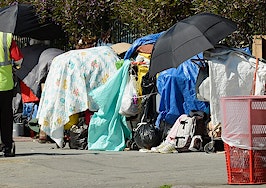San Francisco is one of the nation’s most expensive metros, with an average $9,249 monthly cost of living (excluding housing) for a family of four. So it’s no surprise that the city has an enormous homelessness epidemic, with nearly 10,000 people living on the streets.
Unhappy with the city’s current solutions, which mainly rely on police action, homeowners in Mission Dolores raised $2,000 to place 24, 100-pound boulders on the sidewalks of Dolores and Market streets to keep homeless residents from setting up tents.

The boulders Mission Dolores homeowners placed on the sidewalks | Photo credit: @BrooksKTVU via Twitter
The Public Works Department planned to let the boulders stand, stating they posed no threat to public safety since they didn’t block sidewalk traffic. However, the Department changed course on Monday, saying homeless residents were pushing the boulders into traffic.
Public Works Department director Mohammed Nuru told CNN they’d work with homeowners to create an alternative, which could include landscaping the sidewalk to make it impossible for homeless residents to rest there.
“We’re at the drawing board now,” he said. “We’re definitely going to look at some of the things we have learned.”
Homelessness advocates in San Francisco are calling the boulders and landscaping plan an example of anti-homeless architecture.
“We have 1,200 people on the wait list for shelter,” Coalition on Homelessness executive director Jennifer Friedenbach told SF Gate, while noting the boulders are stripping homeless residents of their only option. “That’s for tonight. People have nowhere to go.”
According to an explainer by the International Network of Street Papers, anti-homeless architecture is defined as a “trend in urban design which discourages the use of spaces in any way other than the intention of the designer or the owner” and “targets the homeless community, an already marginalized group, many of whom look for a place to sleep or rest during the day.”
Examples of anti-homeless architecture include placing boulders on sidewalks and underpasses to stop the formation of tent cities, resurfacing smooth sidewalks with pebbles, gravel and rocks so it’s difficult to sit, and modifying public benches to include multiple arm rests and installing them at a slight curve — both of which make it impossible to sleep.
More extreme examples include placing retractable spikes on stoops, stairs and porches, and placing permanent spikes in restaurant and store enclaves. INSP says retail stores have even used strategically placed speakers that emit a high-pitched alarm to keep homeless people away.
“The emergence of hostile architecture has compounded the moral crisis of our housing shortage,” Transition Projects senior director of public policy and funding Tony Bernal said in INSP’s explainer. “Too often we are leaving people experiencing homelessness with no place — indoors or outdoors — to rest or to be safe.”
In an attempt to lower the number of residents living on the streets, the State of California is drafting its own version of New York City’s “right to shelter” law, which ensures temporary housing for anyone who wants it. If the shelters are filled, the city is then legally required to rent hotel or motel rooms, at the tune of $364 million in 2018.
Proposed by Sen. Scott Wiener (D-San Francisco) in Dec. 2018, SB48 would provide homeless or housing insecure Californians with access to temporary shelter that provides:
A safe place to sleep and keep one’s belongings.
An ability to access shelter without having to sign up on a daily basis.
An ability to remain with one’s partner.
An ability to access services necessary to stabilize one’s life and transition into supportive housing or permanent housing, including mental health, addiction treatment, and other services.
“California’s housing crisis, along with our mental health and addiction challenges, are driving people into homelessness, and we must act,” Senator Wiener said in a prepared statement. “We must do more to ensure homeless people have access to shelter, as a way to stabilize people’s lives and help them transition to permanent housing.”
“Shelter isn’t the ultimate goal – permanent housing is the goal – but shelter is a critical step in helping people get back on their feet,” he added.
As of May 2019, SB48 has passed the housing, governing and finance, environmental quality, and senate appropriations votes, with the bill being placed on a suspense file, which gives Senate members the opportunity to determine the bill’s fiscal impact and vote prior to fiscal committee deadlines.
Proponents of SB48 say it will fulfill homeless residents’ needs for safe shelter while addressing homeowners and renters complaints. Meanwhile, critics say SB48, much like anti-homeless architecture, is merely placing a bandaid on the real issue — unaffordable permanent housing.
“When asshole politicians want to introduce shit, they always point to another city that’s doing something, and therefore must be doing it better,” Western Regional Advocacy Program executive director Paul Boden told Vice News. “They point to everything but housing as the answer.”
Current estimates say California needs to build 3.5 million homes by 2025 solve the housing crisis that has been raging since the 1970s. Furthermore, a majority of those new buildings would need to be affordable (the rent or mortgage must account for no more than 30 percent of a resident’s monthly income) to help the nearly 50 percent of Californians who can’t afford the cost of living in their area.
To close the gap quicker, experts have suggested doing away with strict zoning codes that stall the development of multi-family housing. The state could also follow in the footsteps of Oregon and eliminate single-family zoning in cities with more than 10,000 residents.
“We know empirically that the crisis is driven and exacerbated by a lack of permanent housing,” LA Community Action Network Pete White added. “There is no way we fix the situation by using a 1980s New York solution to solve a 2019 problem.”
































